MARIANI’S
August
30, 2009
NEWSLETTER
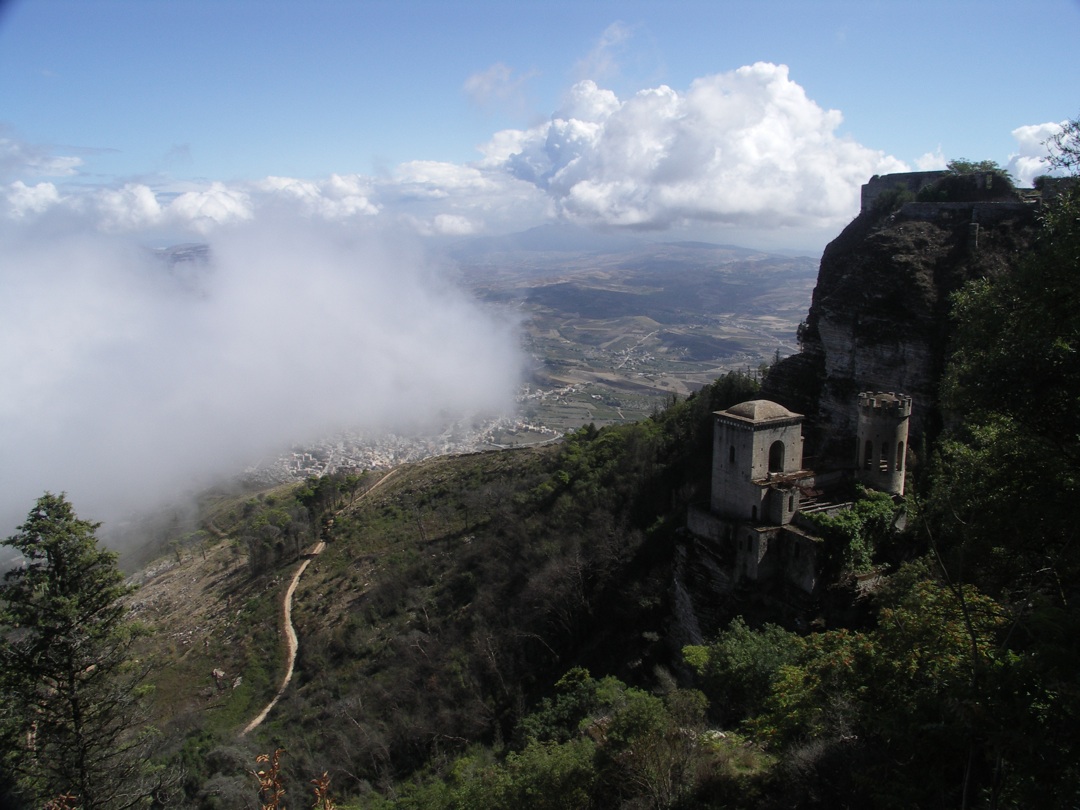
Savoca, Sicily (2008) Photo by Galina
Stepanoff-Dargery
~~~~~~~~~~~~~~~~~
QUESTIONS? TO REACH JOHN MARIANI
WRITE
TO: newsletter@johnmariani.com.
ARCHIVE: Readers may now access
an
Archive of all past newsletters--each annotated--dating back to July,
2003, by simply clicking on www.johnmariani.com/archive
SUBSCRIBE AND
UN-SUBSCRIBE: You may subscribe anyone you wish
to this newsletter--free of charge--by
clicking here.
In
This Issue
Sicily
by John Mariani
NOTES FROM THE WINE CELLAR: Labor Day Wines for Labor Day Foods by John Mariani
QUICK BYTES
~~~~~~~~~~~~~
Sicily
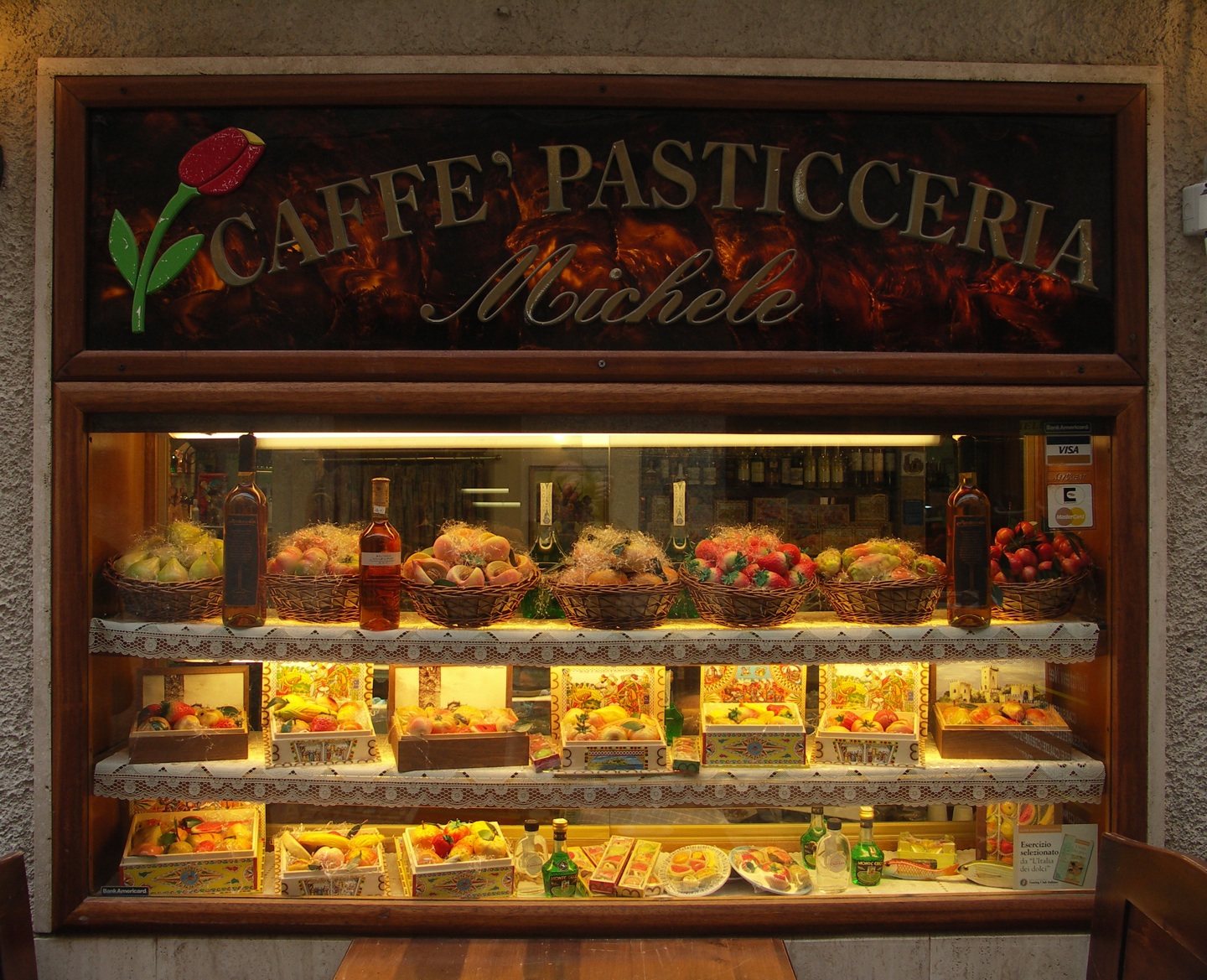
by John Mariani
Photos by Galina Stepanoff-Dargery
Few places on earth have been so fought over, so occupied, so siren-like as the island of Sicily, situated squarely in everyone's way in the Mediterranean, a ripe target for plunder, pleasure, and civilizations to prosper. The Greeks, the Romans, the Ostrogoths, the Arabs, the Normans, the Spanish, and the French all wanted it and kept it until driven out, not by Sicilians, but by the next great power, so that the native population has both suffered and adapted, intermarried and intertwined with European royalty, while never giving up their own ancient spirit of rebellion.
To understand Sicily, one must read Giuseppe di Lampedusa's great 1958 novel Il Gattopardo (The Leopard), about the imposing nobleman Don Fabrizio, who is riven by his understanding that, with the unification of Italy in 1860, everything he knows and cherishes must change, while most of his countrymen regard it as yet another foreigners' imposition.
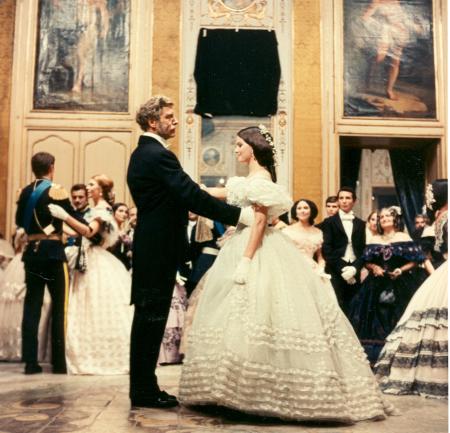 "Sleep,"
says
the Don, "that is what Sicilians want, and they will always hate
anyone who tries to wake them, even in order to bring them the most
wonderful gifts. . . . This violence of landscape, this cruelty of
climate, this continual tension in everything, and these monuments,
even, of the past, magnificent but incomprehensible because not built
by
us and yet standing around like lovely mute ghosts. . . . All these
things have formed our character, which is conditioned by events
outside our control as well as by a terrifying insularity of mind."
"Sleep,"
says
the Don, "that is what Sicilians want, and they will always hate
anyone who tries to wake them, even in order to bring them the most
wonderful gifts. . . . This violence of landscape, this cruelty of
climate, this continual tension in everything, and these monuments,
even, of the past, magnificent but incomprehensible because not built
by
us and yet standing around like lovely mute ghosts. . . . All these
things have formed our character, which is conditioned by events
outside our control as well as by a terrifying insularity of mind."Burt Lancaster and Claudia Cardinale in the film "Il Gattopardo," made by director Luchino Visconti based on the novel by Giuseppe di Lampedusa.
Sicilians are the most unrevealing of Italians because they think of themselves as quite separate from other Italians, and many Italians, who slurringly refer to them as "africani," think the same of the Sicilians. So a traveler arrives in Sicily, stunned by its beauty, awed by its antiquity, delighted by its food, and charmed by the outward show of hospitality in the hotels and restaurants. But it is as difficult to understand the Sicilian's soul as it is his dialect, which is purposefully indecipherable to most most Italians.
So, like all travelers, you give in to Sicily and it responds according to the guidebooks' descriptions. As good a place to begin with an eye to stunning beauty is Taormina, overrun with tourists in summer, but so gloriously perched atop a bluff over the Ionian Sea that a Sicilian friend of mine once explained to me, "If you want to know what Taormina is like, think of paradise, then think harder."
There is still much that is medieval in the town, founded by Greeks, with Norman and Arab accretions added to the Greek structures like the Hellenic theater here, capable of seating 5000 people. Higher still is the tiny town of Castelmoda, which affords a spectacular view of the sea and is far less crowded than Taormina itself. In the distance is the looming Mt. Etna, whose eruptions in 1971 and 1983 caused considerable damage in the region.
My wife and I spent a good deal of time just strolling the streets of Taormina, shopping along the Corso Umberto I, tantalized by the sweet smells of the cafés and gelaterias, so by early afternoon we were ravenous for lunch, and on the recommendation of a Sicilian friend, we walked down a vicolo from the main street, passed through
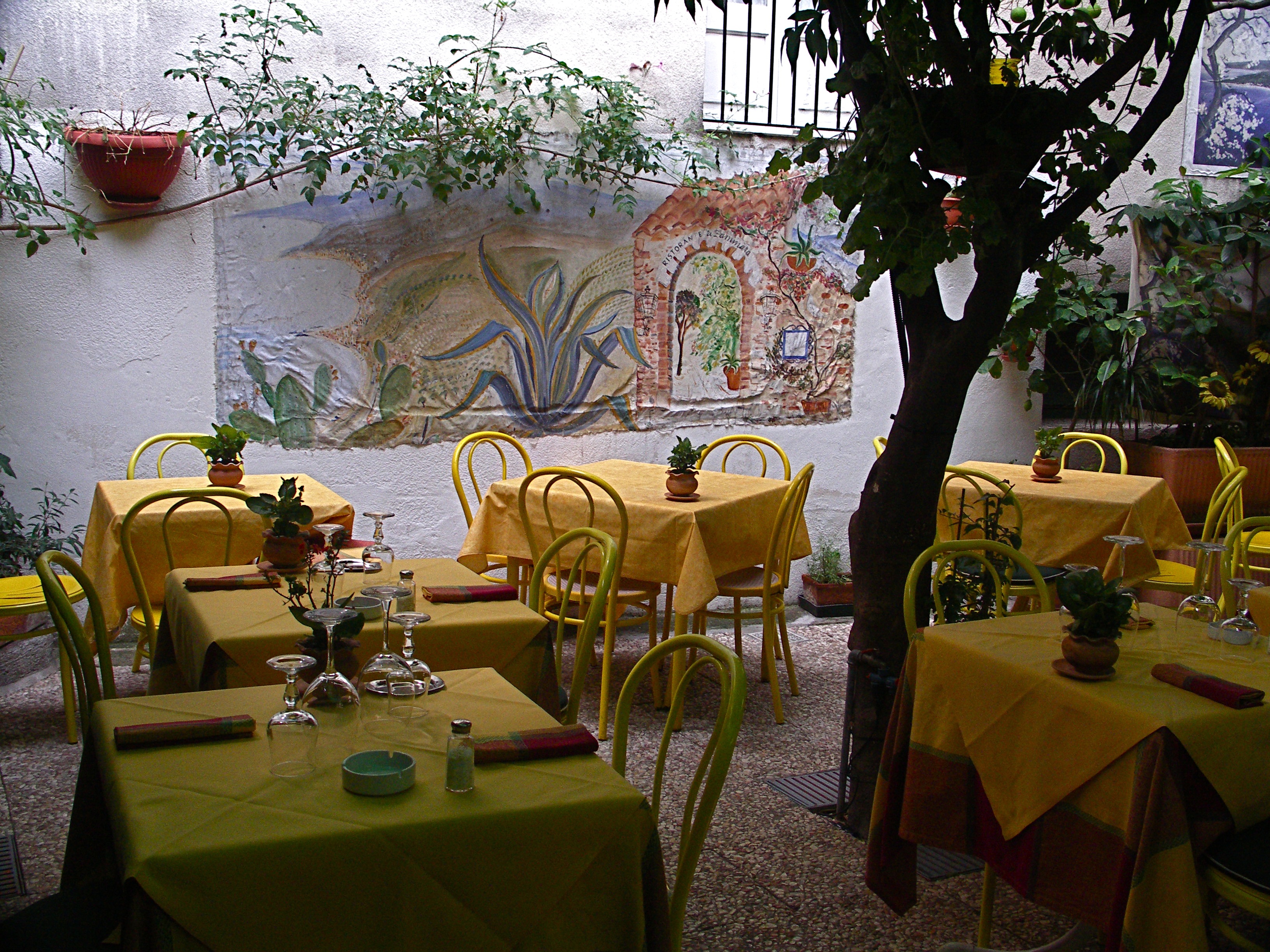 a
wrought-iron gate, and were
warmly greeted by manager/owner/chef Pippo Vinciguerra at Ristorante à Zammara
(right), here since 1988. The
rustic al fresco dining area (with a roll-over
canopy for when the rains come, which they did in buckets that day) was
bright with yellow and green colors, charming folkloric murals, ivy and
orange
trees, with a well-known painted wagon wheel on one wall.
a
wrought-iron gate, and were
warmly greeted by manager/owner/chef Pippo Vinciguerra at Ristorante à Zammara
(right), here since 1988. The
rustic al fresco dining area (with a roll-over
canopy for when the rains come, which they did in buckets that day) was
bright with yellow and green colors, charming folkloric murals, ivy and
orange
trees, with a well-known painted wagon wheel on one wall.We sipped a Rami Inzolia Grecanico 2007 with lovely chestnut notes buoying its crisp, volcanic dryness, with only 12.5 % alcohol. It went splendidly with penne pasta à zammara (11€) with a sauce of tomato, onions, cream, and spinach, and a bowl of fresh tagliolini with shrimp and pistachios from the nearby town of Bronte (12.50€). Involtini of swordfish followed, alla rusticana, with a quickly made tomato sauce, and a red snapper, simply grilled and glossed with olive oil and lemon. For dessert have the cassata or the refreshing limoncello sorbetto.
We sailed from Taormina around Sicily's coastline northwest to the town of Trapani, a port city (with airport) worth an hour's walk-around down the Via Garibaldi to the Piazza Vittorio Veneto. But we rented a car here and drove to nearby Erice, one of the loveliest of cobblestoned hilltowns in the region, on top of Monte San Giuliano. Resolutely medieval, even with runic inscriptions dating back to the Phoenicians, Erice is a town of winding narrow streets that seem always to circle back to a familiar point, always with a church within view. Its pastry shops are filled with the most beautiful marzipan fruits (below) that are a Sicilian specialty. This is a good town to stay put in if you're going to explore the western territory of Sicily, within easy drive of Marsala, home to the famous dry and sweet wines of the same name; Selinunte, with its antique ruins and wind from the coast; and the wonderful fishing village of Castelmare del Golfo.
We stayed at a small, comfortable hotel in Erice called the Elimo, which rented for 130€, including breakfast, per night. English is spoken well here. There is a small restaurant on premises, but it's pretty grim looking and few people seemed attracted to it. Instead, we found a very good Pizzeria Venus just up the block at 5 Via di Martino. Décor is not its strong point, the weak lighting and old Caravaggio prints don't bring much vitality to the evening, but the food is very good, including a classic pizza alla margherita and another alla diavolo, with funghi porcini, mozzarella, tomato, and spicy salami--both large in their diameter, the crust excellent. With coperto, mineral water, a 16€ wine, and some vegetables, the bill came to 50€, including servizio.
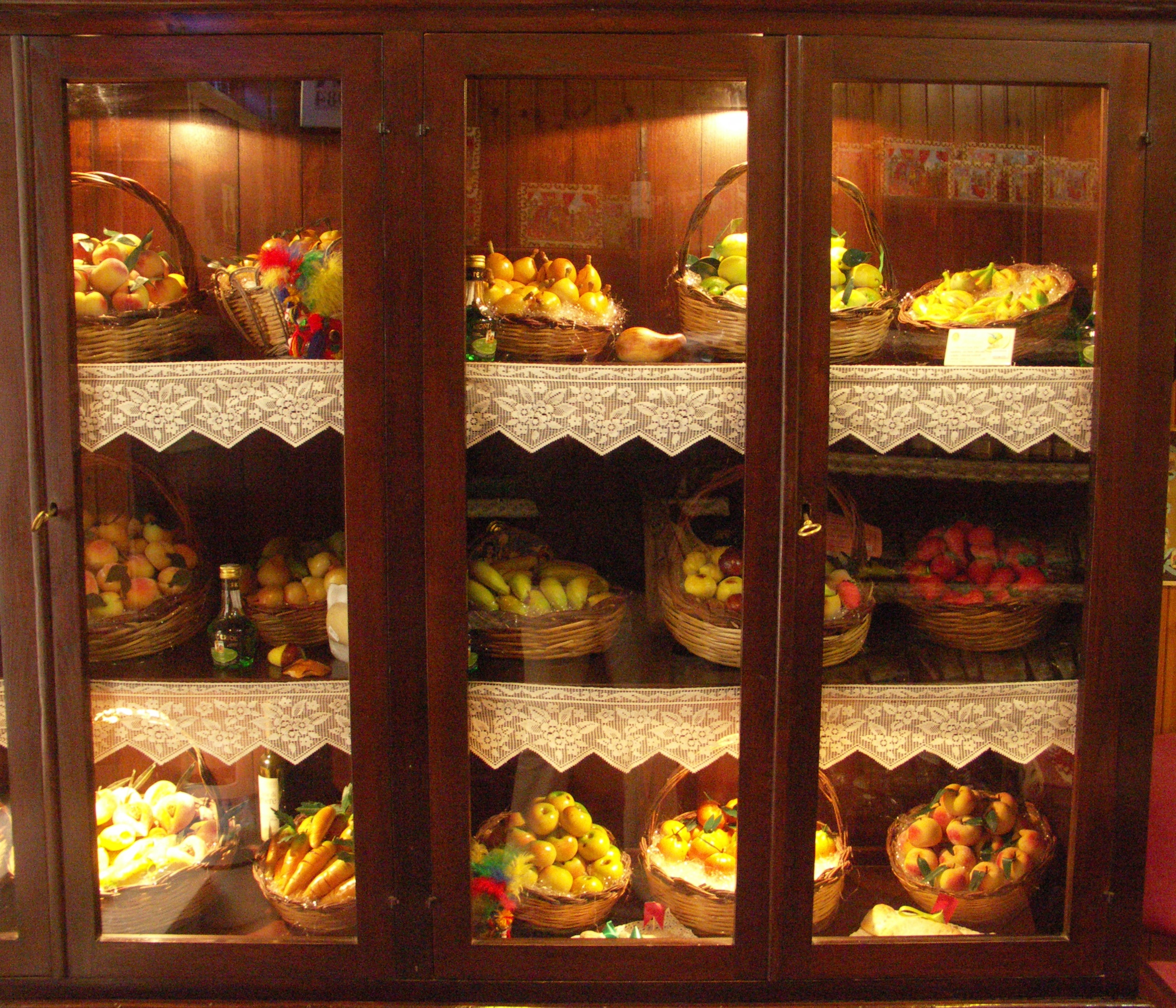 Our
other meal was a long lunch at
a very popular place in Erice, both with the locals and visitors--Monte San Giuliano, a lovely ristorante with pretty
arched indoor dining rooms and an outdoor patio
with white umbrellas. The food here is excellent and remarkably modest
in price, with first courses 6€-10€, pastas 8€-10€, and
main courses 12€-18€. These include very Sicilian dishes
like pasta con sarde, with
sardines, spaghetti alla
frutti di mare
and rigatoni alla Norma
with eggplant and tomato
and mozzarella. (The story goes that the dish was created for the debut
of 1821 opera Norma by
Bellini, who came from Catania in Sicily.) Fish is the specialty
here, as in most Sicily
restaurants, and we thoroughly enjoyed the swordfish al salmorigano,
with a little garlic, parsley, lemon, and oregano, and an oven-baked
grouper "millefoglie," in
flaky pastry layers.
Our
other meal was a long lunch at
a very popular place in Erice, both with the locals and visitors--Monte San Giuliano, a lovely ristorante with pretty
arched indoor dining rooms and an outdoor patio
with white umbrellas. The food here is excellent and remarkably modest
in price, with first courses 6€-10€, pastas 8€-10€, and
main courses 12€-18€. These include very Sicilian dishes
like pasta con sarde, with
sardines, spaghetti alla
frutti di mare
and rigatoni alla Norma
with eggplant and tomato
and mozzarella. (The story goes that the dish was created for the debut
of 1821 opera Norma by
Bellini, who came from Catania in Sicily.) Fish is the specialty
here, as in most Sicily
restaurants, and we thoroughly enjoyed the swordfish al salmorigano,
with a little garlic, parsley, lemon, and oregano, and an oven-baked
grouper "millefoglie," in
flaky pastry layers.We drove throughout the entire region, through the vast forest and nature reserve, Riserva dello Zingaro, where eagles and falcons arc through the blue skies, and down to Segesto, the magnificent site of Doric temples from the 5th century B.C. Just outside of town Salemi, a pleasant farm town with a fine old medieval castle and museum of sacred art, we had lunch at a darling restaurant named Valentino on the Corso da Gorgazzo. It's not all that easy to find, up a winding turn in the road, off to the side of another, but once there we thought we were out of luck because it looked closed at one p.m.
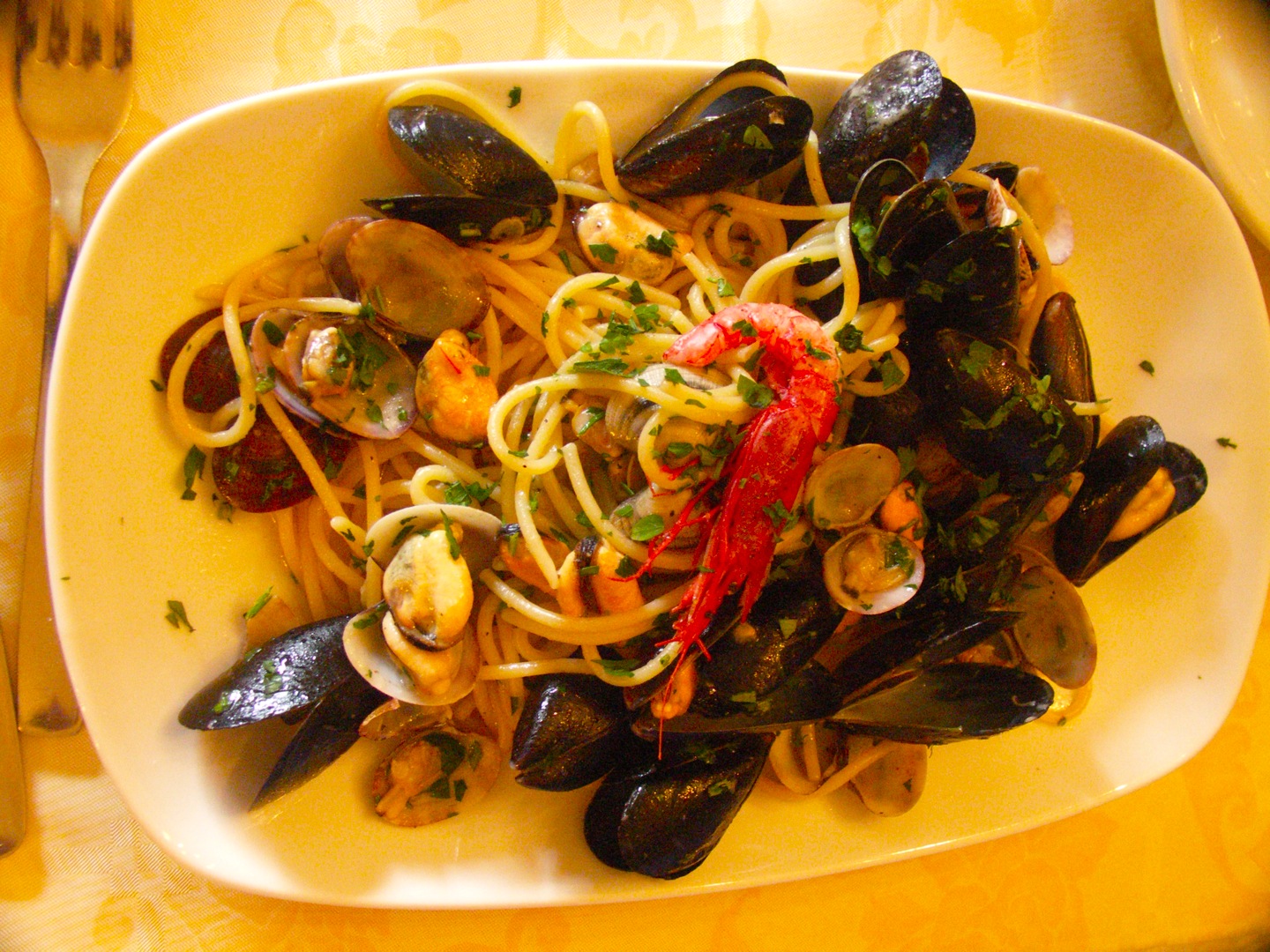 We parked in the large gravel lot and
knocked, to be greeted by a very nice young woman who turned on
the lights and welcomed us if we were their personal guests, soon
joined by another few tables that afternoon. The red-shirted padrone of the place, a
big round man with not a hint of a smile, carried
out wet wooden crates of seafood that had just been brought to the
restaurant that morning, on ice and newspaper sheets--orata, branzino, persico, aragosta,
spigola, soglio. He asked what we wanted to eat, made
suggestions, and was gone to the kitchen.
We parked in the large gravel lot and
knocked, to be greeted by a very nice young woman who turned on
the lights and welcomed us if we were their personal guests, soon
joined by another few tables that afternoon. The red-shirted padrone of the place, a
big round man with not a hint of a smile, carried
out wet wooden crates of seafood that had just been brought to the
restaurant that morning, on ice and newspaper sheets--orata, branzino, persico, aragosta,
spigola, soglio. He asked what we wanted to eat, made
suggestions, and was gone to the kitchen.The décor at Valentino is not untypical--the usual tile floors, ceramic plates on the walls, a brick bar to the right, and yellow plastic tablecoverings. There was a large old antique radio of interest against one wall. The winelist is serviceable and we opened a bottle of Donna Fugata Damaskin Cataretto 2007 (10€), wonderfully fruity and fresh to go with the spaghetti al frutti di mare with clams and mussels (right) and spaghetti with gambero rosso (red shrimp) sauce with pureed zucchini. My wife and I split a large branzino, carefully grilled and given a benediction of good olive oil and lemon. The bill came to 65€.
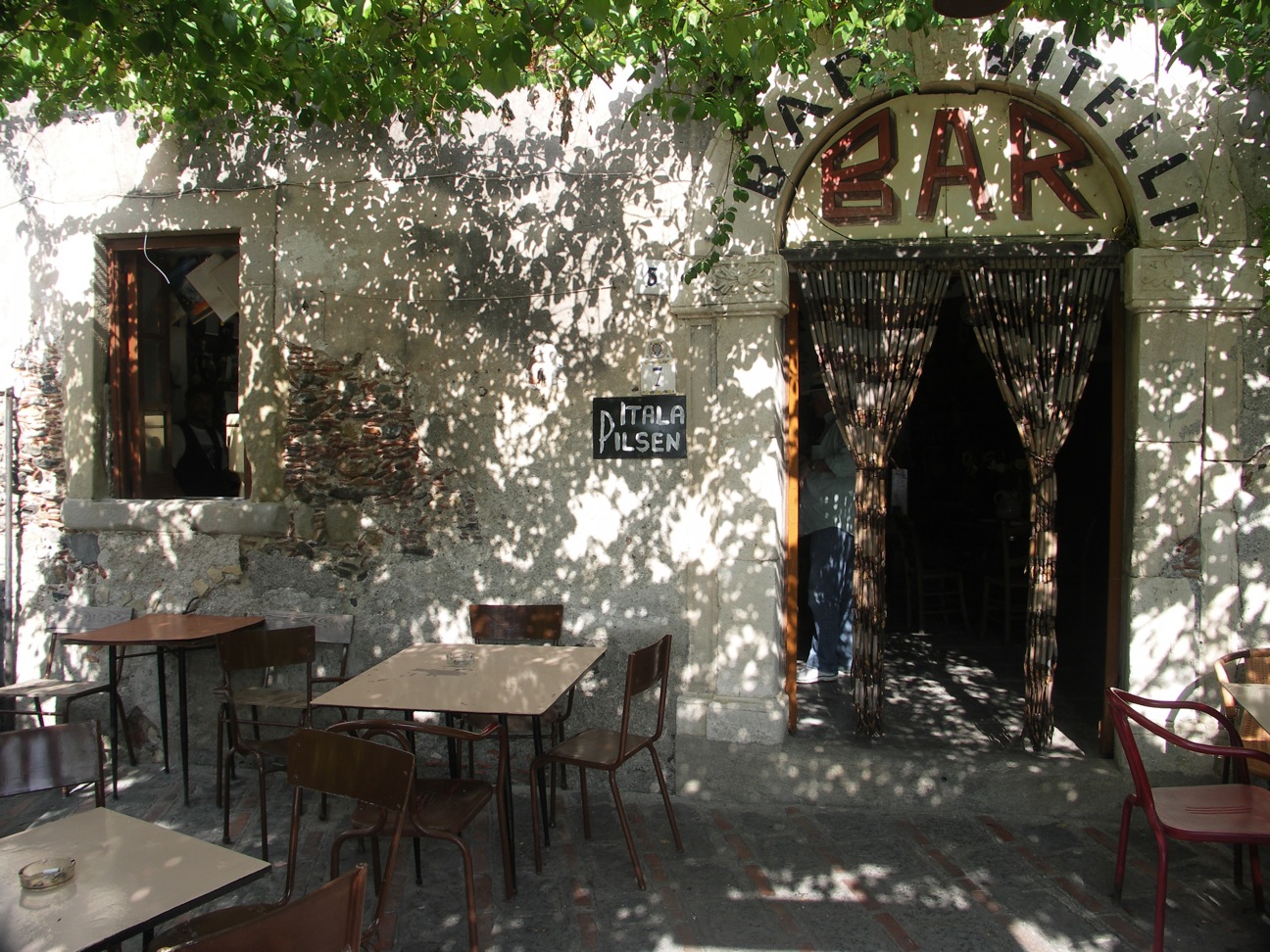 It was
frequently suggested we visit
the tiny
hilltown of Savoca, which has
gained something of a reputation as an arts center, meaning there are
several artisans who live and work in this pretty town, made famous as
the
location for scenes where Michael Corleone, after escaping
America, woos and weds a Sicilian girl in "The Godfather."
This has made tiny Savoca an international tourist destination, but
its
smallness and remoteness precludes it from being overwhelmed. The
church and the actual café where
Michael spoke to the girl's father about her hand in marriage are here:
it's called Bar
Vitelli (left), decked
out with "Godfather" photos and constantly
playing music from the film. Have a cappuccino, listen to the mandolins
and violins play "Speak Softly, Love," and just smile.
It was
frequently suggested we visit
the tiny
hilltown of Savoca, which has
gained something of a reputation as an arts center, meaning there are
several artisans who live and work in this pretty town, made famous as
the
location for scenes where Michael Corleone, after escaping
America, woos and weds a Sicilian girl in "The Godfather."
This has made tiny Savoca an international tourist destination, but
its
smallness and remoteness precludes it from being overwhelmed. The
church and the actual café where
Michael spoke to the girl's father about her hand in marriage are here:
it's called Bar
Vitelli (left), decked
out with "Godfather" photos and constantly
playing music from the film. Have a cappuccino, listen to the mandolins
and violins play "Speak Softly, Love," and just smile.Northward we drove to Castelmare del Golfo (below), whose surrounding area of mountains and hills seeming to tumble down into the sea have a primitive majesty that puts you in mind of all the history that passed through the Mediterranean when sailors used such monumental structures as beacons for guidance. The town of Castelmare del Golfo receives its share of tourists because of the beauty of Gulf itself, against which is set an arching seaside promenade, lined with one seafood restaurant after another, all with more or less the same menu. We stayed at a very nice, 38-room hotel, Al Madarig on the Piazza Petrolo with decent-sized rooms and a well-spoken concierge. Located near the Arabic castle and within a moment's walk of the old town and Gulf, it was a good bargain at only 102€ for two people.
Probably not now, but while tourism was at its height in Italy two years ago, it became usual practice in tourist centers like Rome, Florence, and Venice to dumb down the cooking and raise the prices. Chefs seemed to shrug
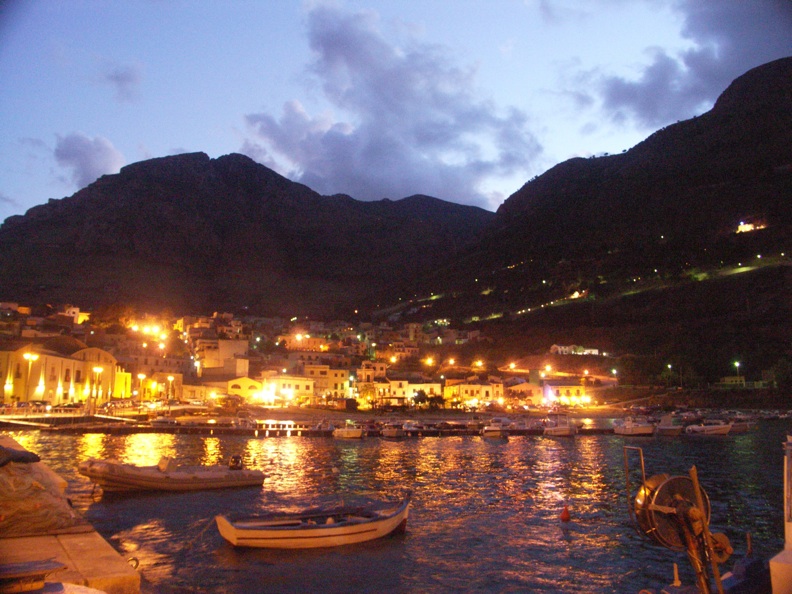 and say,
"These people don't know what they're eating anyway," and that
sentiment
seems to have trickled down to Castelmare del Golfo--at least where we
ate, at Ristorante La Cambusa.
The reason we chose it was because
it was packed and lively, and it is a good sign when a seafood
restaurant does volume because they go through a lot of fresh fish each
day. The décor is pleasant if forgettable, the lighting all
right, and the view of the
water dreamy. But the food was terrible, not far behind the
frenetic service. Couscous, which the Sicilians appropriated from
Arab food
culture, is a specialty in many restaurants here, but La Cambusa's
version was
a
dreadful, pet-food-looking mess, and fishy to boot--a big plate of
soupy rice gruel with shards of seafood in it and little or no
seasoning. Better by a bit was a frittura of seafood, which
everyone seemed to be ordering, but there was nothing to praise about a
plate of limp spaghetti with a weak pesto sauce. The bill, with
one bottle
of Planeta La Segreta white wine (13€) came to 60€.
and say,
"These people don't know what they're eating anyway," and that
sentiment
seems to have trickled down to Castelmare del Golfo--at least where we
ate, at Ristorante La Cambusa.
The reason we chose it was because
it was packed and lively, and it is a good sign when a seafood
restaurant does volume because they go through a lot of fresh fish each
day. The décor is pleasant if forgettable, the lighting all
right, and the view of the
water dreamy. But the food was terrible, not far behind the
frenetic service. Couscous, which the Sicilians appropriated from
Arab food
culture, is a specialty in many restaurants here, but La Cambusa's
version was
a
dreadful, pet-food-looking mess, and fishy to boot--a big plate of
soupy rice gruel with shards of seafood in it and little or no
seasoning. Better by a bit was a frittura of seafood, which
everyone seemed to be ordering, but there was nothing to praise about a
plate of limp spaghetti with a weak pesto sauce. The bill, with
one bottle
of Planeta La Segreta white wine (13€) came to 60€.And so it was back to Palermo for a day before returning to the USA via Rome. I cannot claim long familiarity with Palermo, having visited it only twice before, but I was happy this time to see it reclaimed from the negligence of centuries, its monuments cleaned up, its streets passable, its markets flush with fresh provender and seafood. There was a youthful buoyancy in the inhabitants' steps and the restaurants were doing pretty well. I did learn never again to try to drive a car during the rush hour from 11:30 AM to 1 PM, after which the traffic subsides and the city seems almost empty.
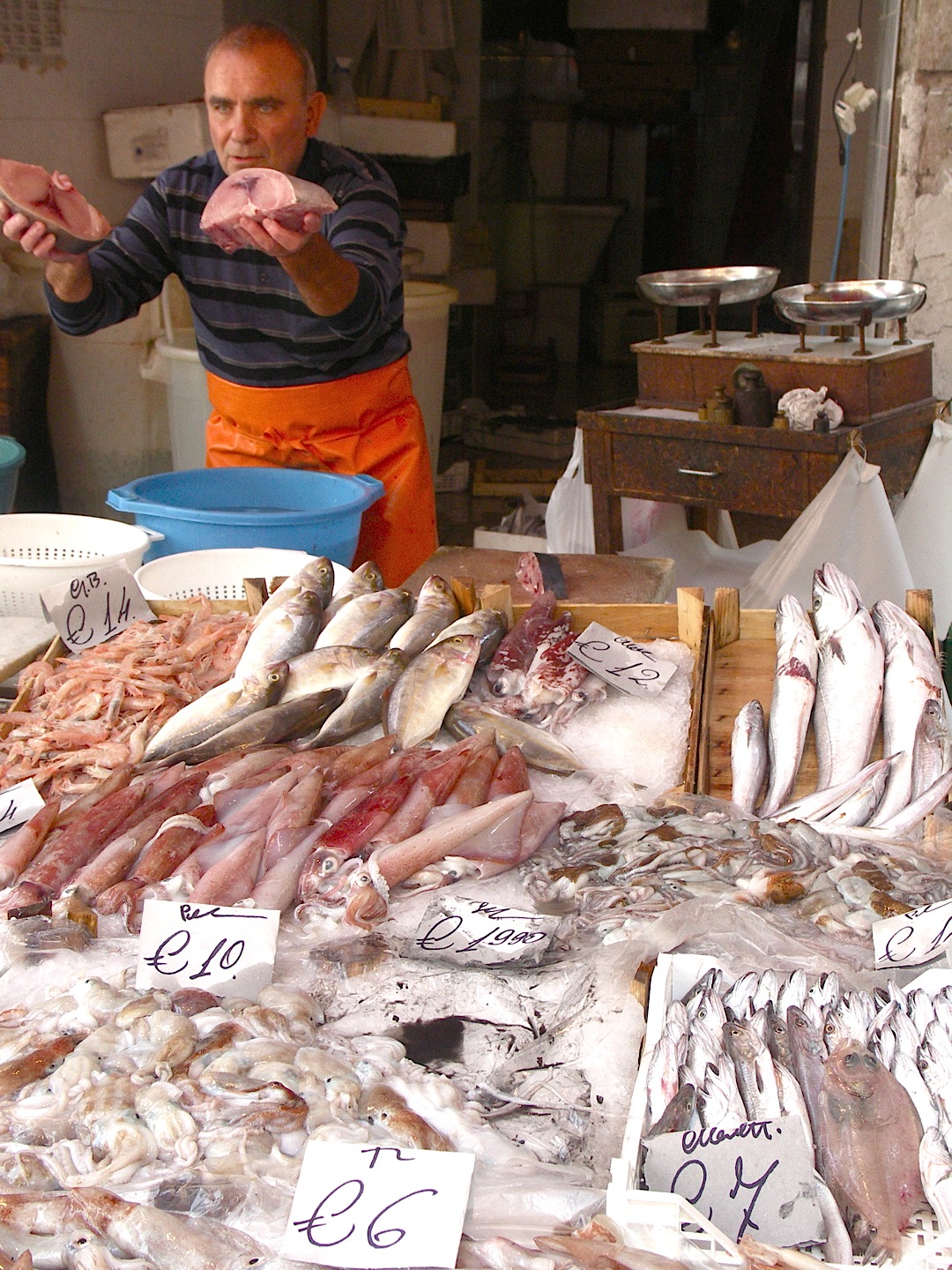 You
can tour most of the most interesting
parts of Palermo in a day, the principal center bisected north and
south. The Piazza Marina is a tree-filled, airy and cool spot
near
the water, just steps from the International Marionette Museum, a
collection of more than 2,000 figures worldwide. Unfortunately we could
not visit the
city's principal art collection, the Palazzo Abatellis, because it was
closed for renovation, so we strolled through the area around the
baroque
Fontana Pretoria and wound our way through the bustling Mercato della
Vucciria (left), where
every imaginable food, vegetable, and fish from the
Mediterranean can be purchased to the tune of a Sicilian shopkeeper's
sing-song dialect. This is one of my favorite spots in Palermo, and
there are several little trattorias right next to the food stalls.
You
can tour most of the most interesting
parts of Palermo in a day, the principal center bisected north and
south. The Piazza Marina is a tree-filled, airy and cool spot
near
the water, just steps from the International Marionette Museum, a
collection of more than 2,000 figures worldwide. Unfortunately we could
not visit the
city's principal art collection, the Palazzo Abatellis, because it was
closed for renovation, so we strolled through the area around the
baroque
Fontana Pretoria and wound our way through the bustling Mercato della
Vucciria (left), where
every imaginable food, vegetable, and fish from the
Mediterranean can be purchased to the tune of a Sicilian shopkeeper's
sing-song dialect. This is one of my favorite spots in Palermo, and
there are several little trattorias right next to the food stalls.Just past the demarcation line is the magnificent and vast Cathedral, in the Norman style, dating to the 12th century, though much expanded over centuries. There are Arabic inscriptions, wonderful Gothic clock towers, and some neo-classical chapels that look very out of place in the interior. Not far away is the immense Teatro Massimo, Palermo's opera house, and there seems to be a remarkably large chapel or church on every corner of the city.
During that lunchtime period of quiet, we decided on a ristorante of some note in the city, Lo Scudiero (below) on Via Filippo Turati, near the museum of Modern Art. (There is another, unrelated restaurant outside of town called La Scuderia.) It has a stone-walled, wood-ceilinged décor and gets a well-dressed business crowd during the day; service is officious but cordial. The menu is fairly large and mostly traditional, but it reminded me of outdated, upscale continental food of a kind you'd find in Italian hotels thirty years ago. You are treated to a glass of spumante, a basket of bread and not very good butter. Grilled eggplant with mozzarella was bland on both counts, and potato gnocchi with white truffle oil and some chopped nuts tossed on top seemed like an attempt at modernity that flopped.
 The
swordfish with risotto was
a mistake, the fish having no flavor, the flavor of fennel pronounced,
and the risotto certainly not
cooked to order. We thought we'd
try the meat here, but stracci
("rags") of beef were chewy and dreadful, the zucchini undercooked.
The
swordfish with risotto was
a mistake, the fish having no flavor, the flavor of fennel pronounced,
and the risotto certainly not
cooked to order. We thought we'd
try the meat here, but stracci
("rags") of beef were chewy and dreadful, the zucchini undercooked.That night we were again disappointed by our meal, though we enjoyed and lingered over our wine at a very popular outdoor spot, with big indoor rooms, called, quite correctly, Antica Focacceria San Francisco (below), on the Via A. Paternostro. The place was established in the historic section of the city in 1834, specializing in the very same dishes--the sfincone and focaccia street food of Palermo--every since. Legend has it that Garibaldi stopped by for a snack on his way to Rome with a thousand troops in tow. Five generations of the same Conticello family have run the place and enlarged it within what was once a chapel, still retaining some of the original furniture. It has charm to burn.
My wife and I arrived around 9:15 in the evening, and it was a beautiful night. A lighted tent hovers the tables surrounded by planters in a square. The winelist is better than it needs to be for a place where most people are ordering pretty casual fare and a lot of beer. The problem here is that the kitchen and the staff have been going through the motions serving packed tables for so long that they've lost the ability to do things the way they should be or perhaps used to be. Practice has not made perfect here. Service can be either too fast or too slow: One dish comes out while the other person waits for his. A salad of bland bufala mozzarella came with cherry tomatoes and dried-out greens. The focaccie were more like rolls with cheese and anchovy, and the baked anelli pasta rings--a Sicilian specialty--with meat sauce was a dish you'd as likely get at the Palermo airport. And spaghetti alla Norma came with big slabs of barely cooked eggplant.
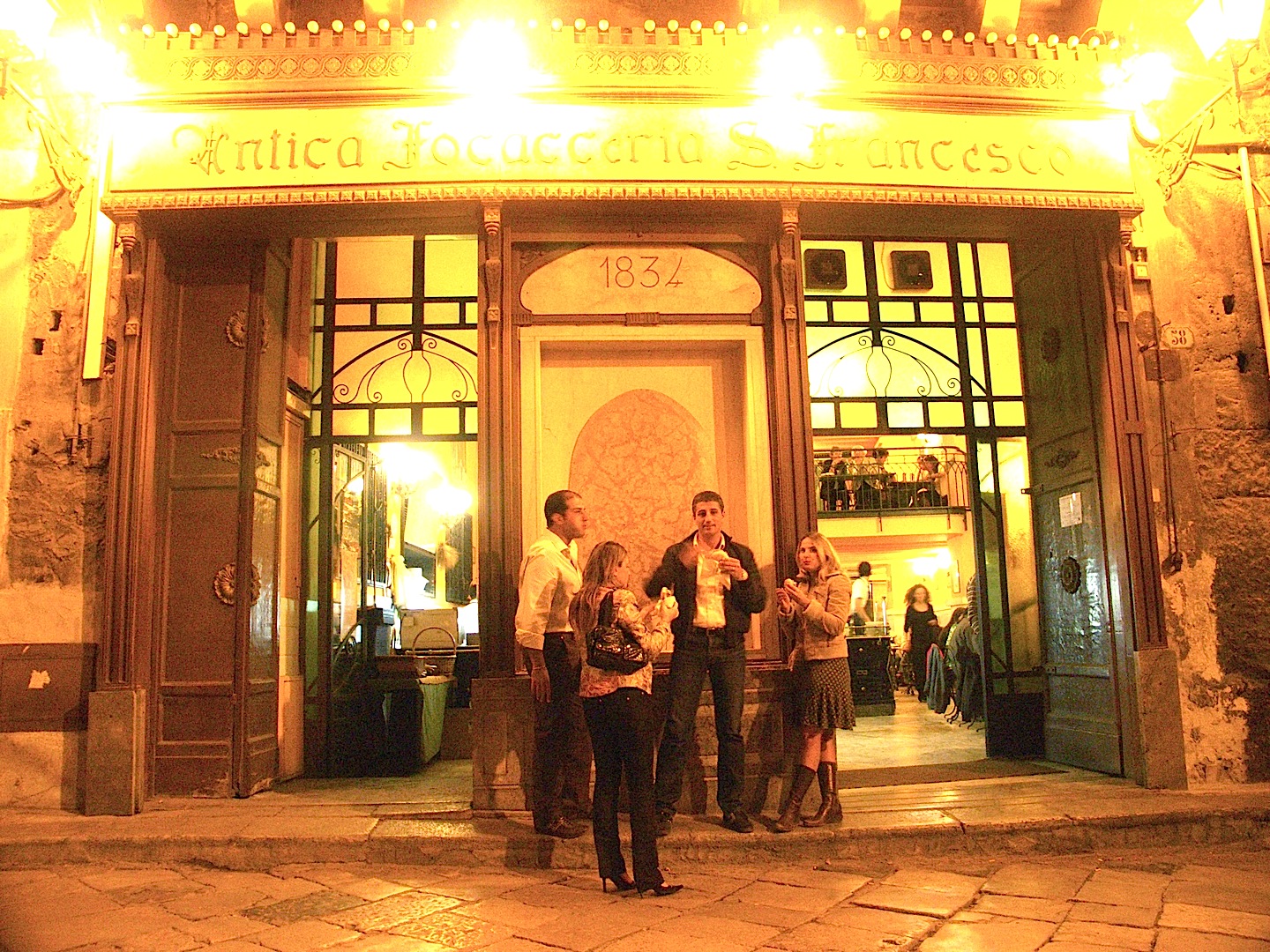 What
makes Antica Focacceria
attractive is its young, laughing crowd, the merriment of the place,
and the
chance to get a bite to eat with a beer or a carafe of wine. But
this is not an example of particularly distinguished Sicilian cookery.
What
makes Antica Focacceria
attractive is its young, laughing crowd, the merriment of the place,
and the
chance to get a bite to eat with a beer or a carafe of wine. But
this is not an example of particularly distinguished Sicilian cookery.Overall, little of the food we ate in Sicily on this tour was outstanding, though on other occasions I've dined very well in Sicily. The food this time was (almost) always very fresh but seafood tended to be overcooked and seasonings did not have the brightness and bold savoriness I'd had in the past. And I learned one more thing: Marsala, which is one of the signature spirits of Sicily, is not much appreciated anymore on the island, so that going to a bar or café and asking for a glass of special Marsala will most likely elicit a shrug and the explanation, "No one really drinks it these days."
But Sicily endures, it changes, but more slowly than has the rest of Italy, and the people pretend not to envy the prosperity of the north. They have the beauty of the blue waters and skies, the gigantic mountains and the green forests, and in the sea they still hear the voices of mermaids drawing everyone to their island.
~~~~~~~~~~~~~~~~~~~~~~~~~
NEW
YORK CORNER
by John Mariani
ASIATE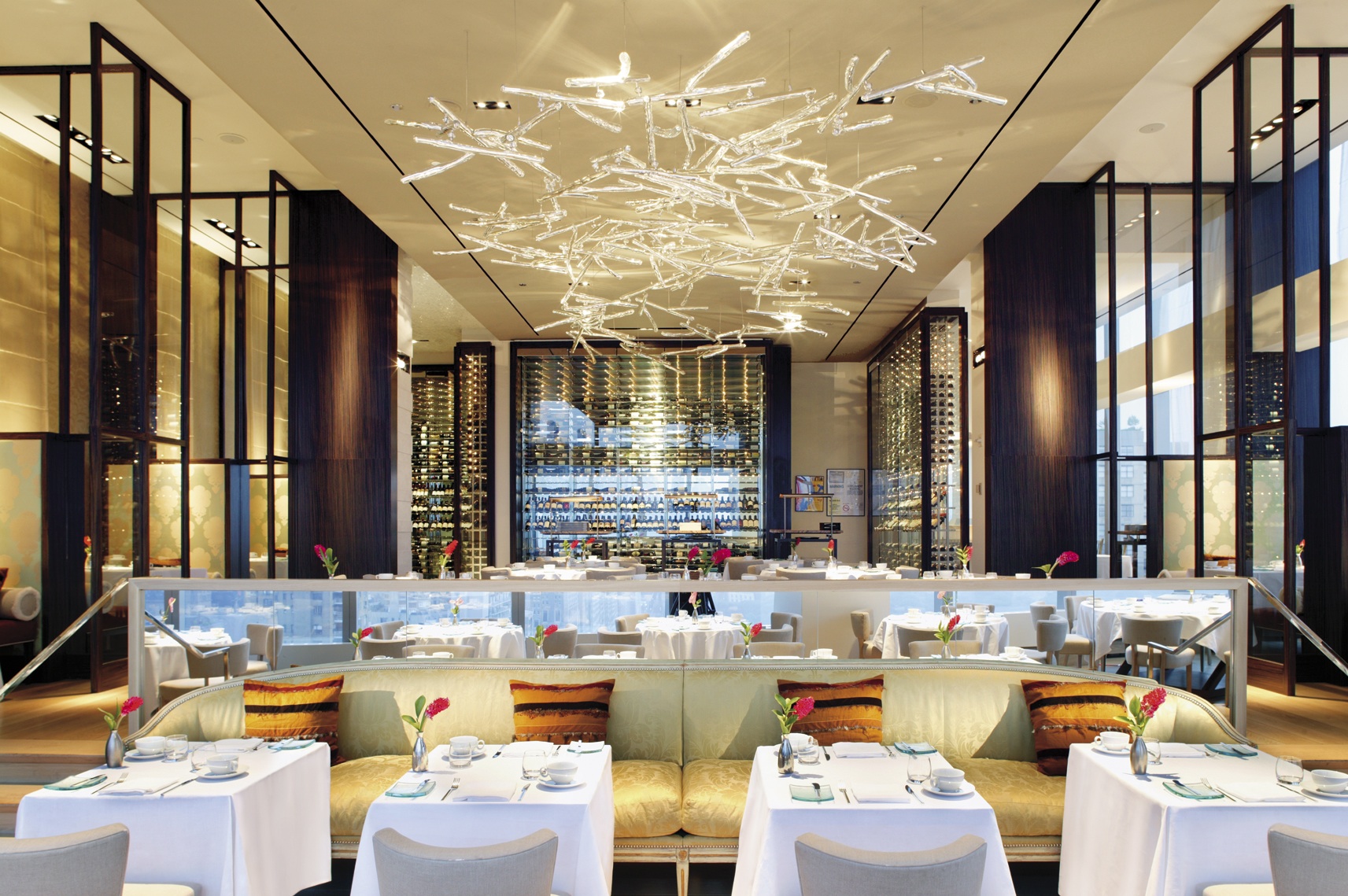
Mandarin Oriental Hotel
80 Columbus Cir
212-805-8881
www.mandarinoriental.com
Like the panorama from several of the restaurants in the Time-Warner Centre, including Porter House and Per Se, the view from Asiate, in the Mandarin Oriental Hotel, covers Columbus Circle, Central Park, Broadway, and the apartment towers of Fifth Avenue. But because Asiate's view is from the 35th floor, it is easily the most spectacular. This would be my first choice for a romantic evening, and it functions at any time as a way to impress your friends and clients.
You enter through a shimmering Lobby Lounge, where you may eat lightly; for exotic Asian cocktails, the MObar is a very sexy spot, starting around six o'clock and going late. To the left is Asiate, where you will be very cordially greeted and shown past a stunning wall of 1,300 bottles of wine to a two-tiered, 90-seat dining room that very probably has been laid
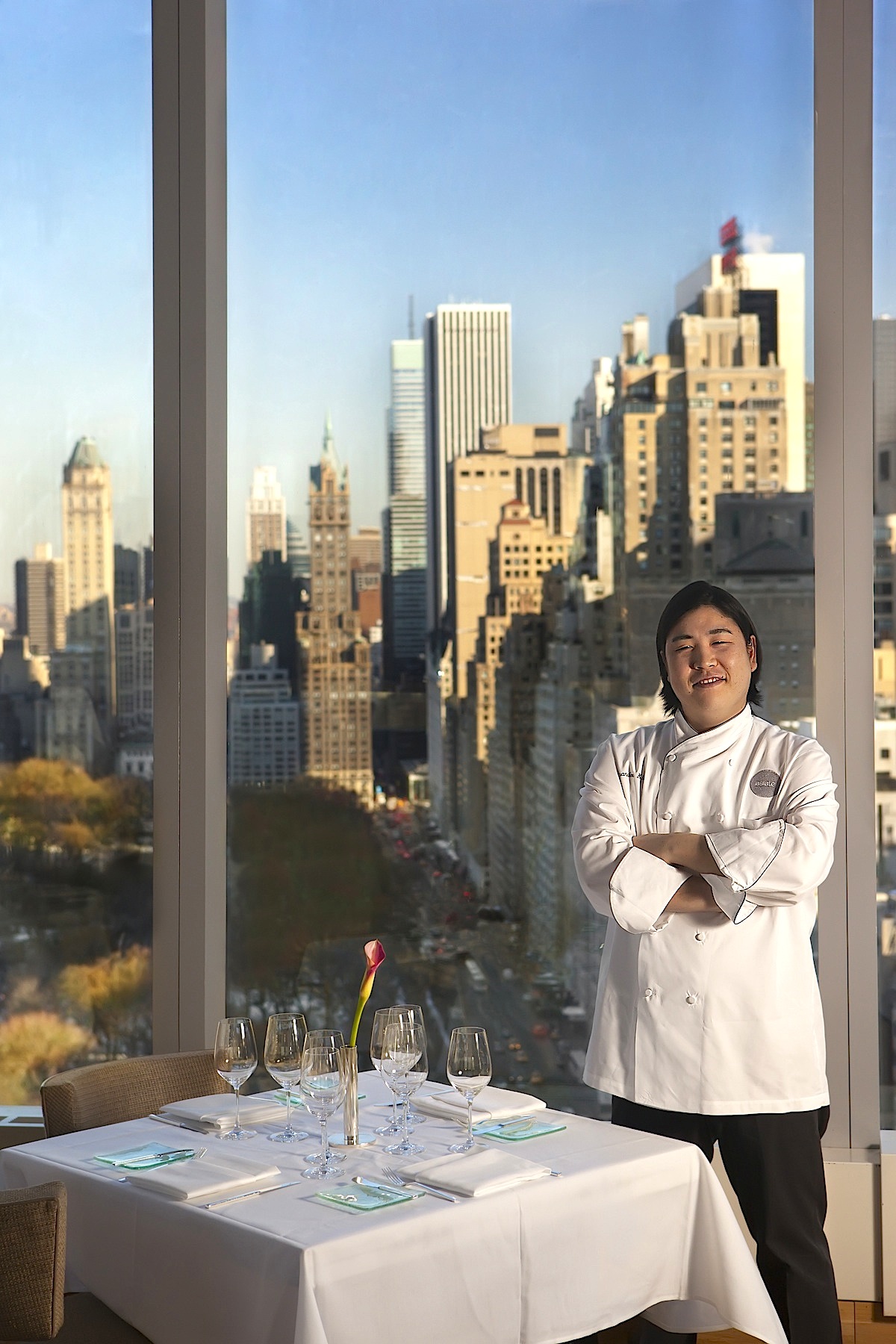 out feng shui style, because it
is of supreme comfort,
good decibel level, and breathtaking beauty. Tables are well set,
glassware thin, serving dishes varied in shape and color.
out feng shui style, because it
is of supreme comfort,
good decibel level, and breathtaking beauty. Tables are well set,
glassware thin, serving dishes varied in shape and color.A new chef has come aboard recently at Asiate, Brandon Kida (left), and I think he's the best the restaurant has had, adding a little heft to a menu that in the past was a little lightweight. His résumé includes stints at Lutèce in NYC and L’Orangerie and Bastide in L.A. He's been at Asiate since it opened in 2003 and came up in the ranks to the top toque. He also spent a month at Mandarin Oriental’s restaurants in Hong Kong and Bangkok.
At a recent lunch I put myself in Kida's hands and was rewarded with beautifully composed but unpretentious renderings of sashimi
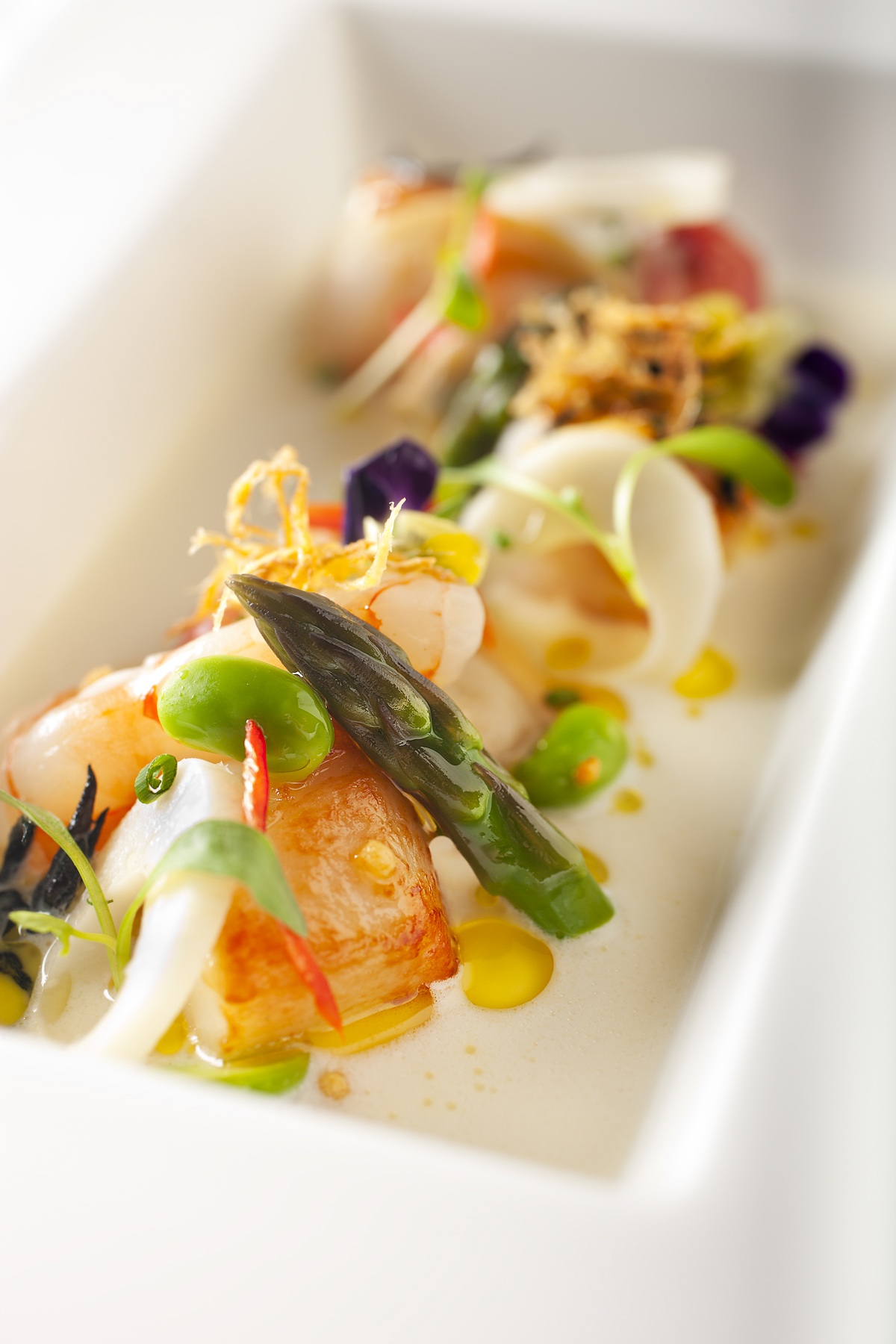 with
avocado mousse, cucumber melon gelée, and mustard ponzu, with which the
delightful sommelier Annie Turso chose a German 2007 Muscat rosé
from
Schnaltmann that was as summery as the sun outside the huge windows at
Asiate.
with
avocado mousse, cucumber melon gelée, and mustard ponzu, with which the
delightful sommelier Annie Turso chose a German 2007 Muscat rosé
from
Schnaltmann that was as summery as the sun outside the huge windows at
Asiate.Next came frogs' legs with a wonderful addition of foie gras mousse, tangy sorrel, and a cherry gazpacho--fusion cuisine with a true individual's sensibility behind it. This was served with Brachetto d'acqui Coppa "Pasione" 2006, a é from Piedmont. The next course was wild salmon--the only kind I ever care to eat--that was glazed with miso and sided with Asian vegetables, spiced Mandarin orange, and a sweet-sour ginger gastrique that was well matched to a cool Terrenrune Bandol Rosé 2007. Dessert was a lemon-lime gâteau with vanilla marshmallow and sudachi citrus sorbet, a light ending to a lunch that was very satisfying, even over four courses, so that I felt quite satisfied, not stuffed. The wines worked their little wonder, too, making that view from Asiate even more enchanting.
Asiate is open for breakfast and dinner daily, lunch Mon.-Fri. Dinner is priced at $85 for 3 courses, with a tasting menu at $125, and weekend brunch at $48.
NOTES FROM THE WINE CELLAR
by John Mariani
Labor Day Wines for Labor Day Foods
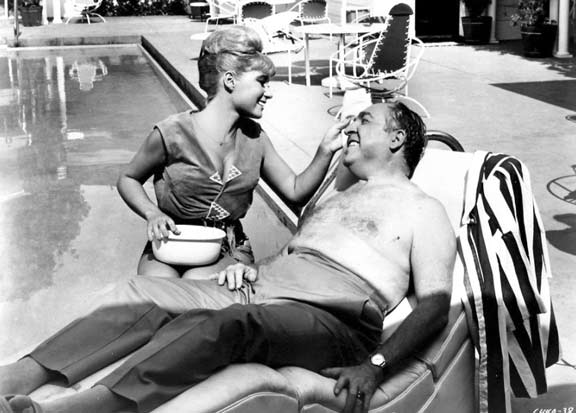 And so summer ends,
with one more outdoor holiday party to go, and Labor Day seems worthier
of shrimp and steak than the franks and burgers that filled the grill
on the Fourth of July. So, too, the frivolous wines of mid-summer give
way to bottlings a bit more serious, without paying too much for the
pleasure of drinking them with good food.
And so summer ends,
with one more outdoor holiday party to go, and Labor Day seems worthier
of shrimp and steak than the franks and burgers that filled the grill
on the Fourth of July. So, too, the frivolous wines of mid-summer give
way to bottlings a bit more serious, without paying too much for the
pleasure of drinking them with good food.The essential simplicity of cooking shrimp and steaks outdoors should allow for a bit more imagination in the choice of wines to go with them. Unless you’re masking the foods’ flavors with various sauces or condiments, you should seek more body and richness in the wines than if the foods were spicy with ketchup, mustard, and hot sauce.
With that in mind I collected five diverse wines each for shrimp and steak on the grill, all under $30 a bottle. Let’s start with shrimp.
Château la Noë Muscadet Sèvre et Maine 2007 ($8-10)—Muscadet should be drunk young and fresh, although
 if kept in barrel “sur lie” (on
the lees) like this example, it’s got more body and a hint of smokiness
that marries well with the grill.
if kept in barrel “sur lie” (on
the lees) like this example, it’s got more body and a hint of smokiness
that marries well with the grill.Château St Jean Sonoma Chardonnay 2006 ($11-$15)—A very sensible style of California chardonnay, at 13.4 percent alcohol, with a balance of citrus and fruit and just enough oak to give it ballast. Great with any shellfish.
New Harbor Vineyards New Zealand Sauvignon Blanc Marlborough 2008 ($10-13)—I am not a fan of the prevailing fruit bomb style of New Zealand sauvignon blancs, but this well-priced example is crisper than most so that the fruit doesn’t overpower the herbaceous quality of the grape.
Louis Latour Montagny 1er Cru La Grande Roche 2005 ($18-22)—With a little age on it now, this fine white Burgundy shows off Montagny’s minerality and chardonnay panache, as befits a Premier Cru from the chalky-limestone region of the Cote Chalonnaise. Just salt and pepper the shrimp, and this will be a magnificent marriage of simple goodness.
Nicolas Les Champs Clos Sancerre 2007 ($22-25)—Sancerre, a sauvignon blanc from the Loire Valley, is my favorite appetizer wine because it has so much flavor, smelling of fresh grass, with a fine, dry finish and low alcohol level perfect for shrimp. This is but one example in this price range sure to deliver value.
Steaks can take on any red wine but deserve one that can enhance the fatty richness and the ferrous flavors of good beef. Cabernet is the natural choice, but if I could have found a Barolo or Barbaresco under $30 for this list, I would just as happily served one.
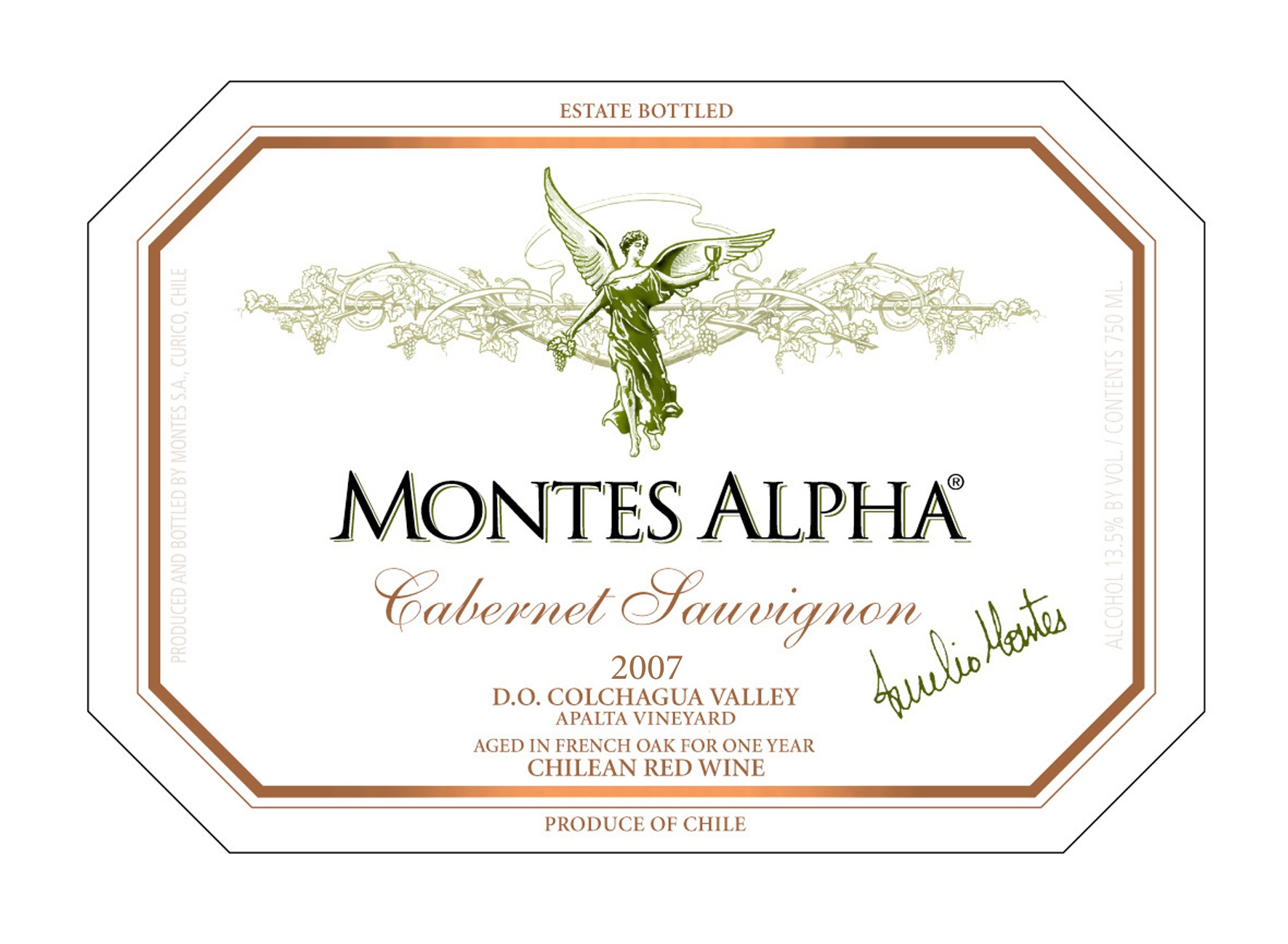 Montes Alpha Cabernet Sauvignon
2005 ($17-$24)—This superb Chilean vineyard produces more
expensive cabs, but at $20 this blows away most of its competition from
California. Big but not bulky, silky and perfumed with good fruit, the
14.5 percent alcohol is tamed by good technique and not too much oak.
Montes Alpha Cabernet Sauvignon
2005 ($17-$24)—This superb Chilean vineyard produces more
expensive cabs, but at $20 this blows away most of its competition from
California. Big but not bulky, silky and perfumed with good fruit, the
14.5 percent alcohol is tamed by good technique and not too much oak.Frescobaldi Remole 2007 ($8-12)—This Tuscan blend of sangiovese and a little cabernet hasn’t a lot of complexity but it is a solidly-knit, consistently delicious steak wine that will just as easily go with any red meat, pork, or chicken. More interesting than most chiantis, a lot cheaper than most sangiovese blends.
Rodney Strong Alexander Valley Cabernet Sauvignon 2006 Estate Vineyards ($25)—I doubt there is
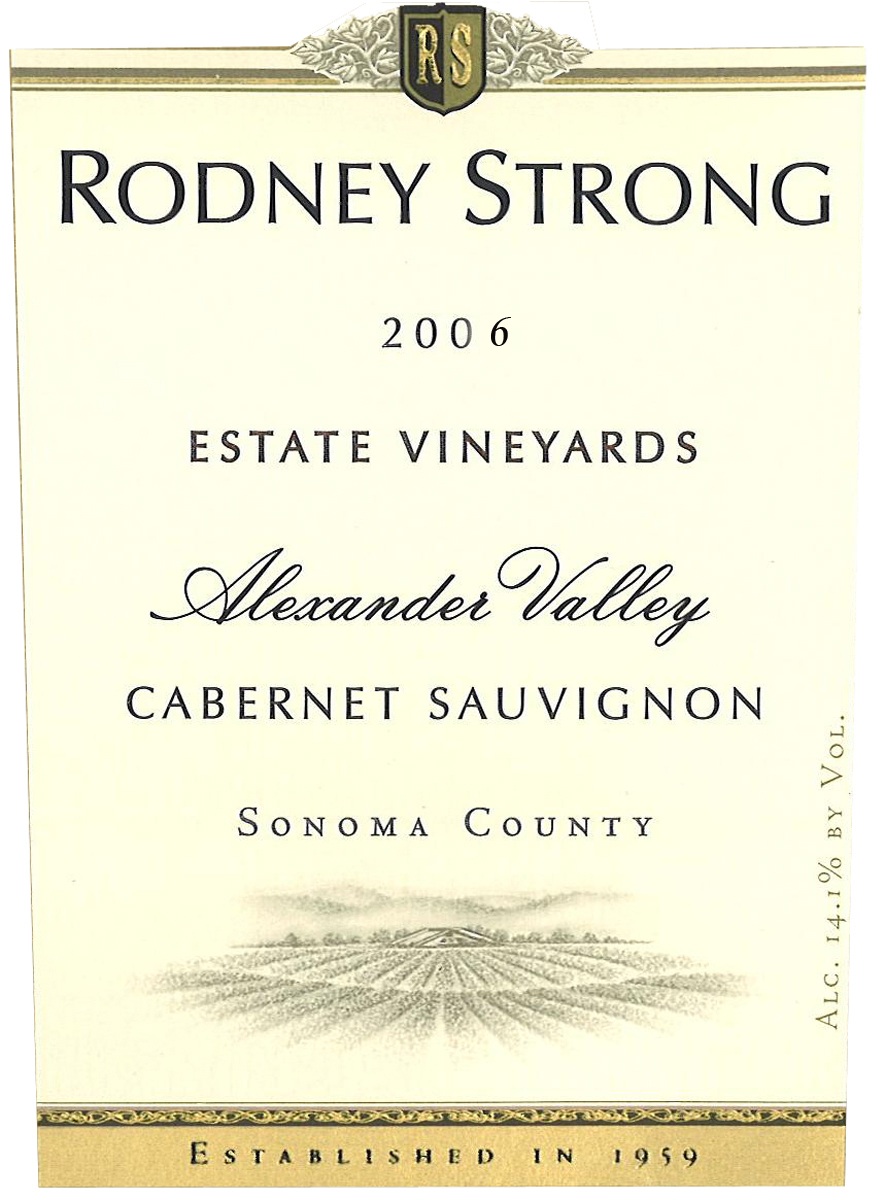 any
winery in California that gives more bang for the buck in a wider array
of wines than Rodney Strong, and this cab, from a hot summer vintage,
is plummy but not overly fruity, with good backbone and acid in tandem,
softened by 21 months in barrel.
any
winery in California that gives more bang for the buck in a wider array
of wines than Rodney Strong, and this cab, from a hot summer vintage,
is plummy but not overly fruity, with good backbone and acid in tandem,
softened by 21 months in barrel.Toasted Head Cabernet Sauvignon 2006 North Coast ($10-$17)—another bargain in California cabs, Toasted Head does not try to be massive, but its light smoky aroma and cedar notes make this a wonderful match for the sizzling char on meat off the grill. The name comes from the winery’s toasting the head staves of its oak barrels to provide flavor.
Susana Balbo 2007 Malbec ($24-27)—Argentinean wineries are pushing, with good reason, to make their mark with malbec, although some can be inky monsters. Susana Balbo’s wines have an exceptional equilibrium of fruit and firm tannins (with a touch of cabernet) that give off complexity that will mellow for years to come. (She also makes a cheaper bottling called Crios de Susana Balbo Malbec that is quite good.)
John Mariani's wine & spirits column appears in Bloomberg Muse News, from which this story was adapted. Bloomberg News covers Culture from art, books, and theater to wine, travel, and food on a daily basis.
~~~~~~~~~~~~~~~~~~~~~~~~~~~~~~
FOOD WRITING 101: Insects of any kind do not make for tasty opening to a restaurant review.

"Restaurants, like fruit flies, make fine subjects for study. With each new generation, they not only teach us truths about their struggle for survival, but they also give us insights into our own behavior and how it shifts according to the times. Witness Nopalito, a small, warm-blooded creature that seems perfectly adapted to an unforgiving climate. While older restaurants gasp for air in our post–asteroid strike economy, Nopalito, which was hatched amid the dust cloud, thrives."-- Josh Sens, "Holy mole! South-of-the-border fare arrives north of the Panhandle at Laurence Jossel’s new Nopalito."--Josh Sens,—San Francisco Magazine
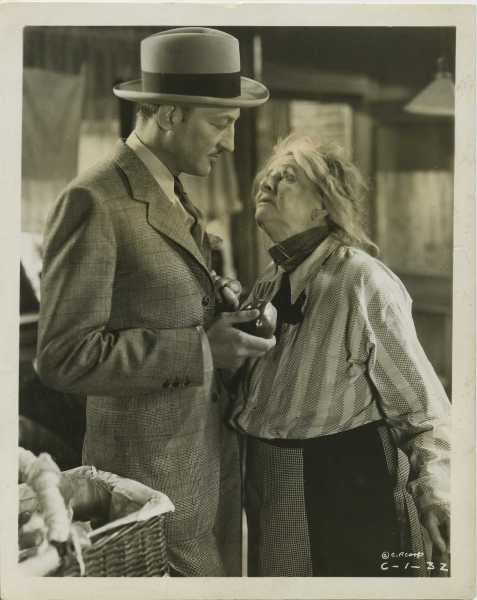
TIMES IS TOUGH ALL
OVER, RUTHIE!
According to the NY Post, Ruth Madoff, wife of Bernie the Con, tried to order a salad and white wine at a California Pizza Kitchen in NYC by using food coupons. "The waiter said she was upset because she had coupons and they expired before she could use them," a witness told the newspaper, adding that several diners told the waiters they shouldn't serve her.
~~~~~~~~~~~~~~~~~~~~~~~~~~~~~~~~~~
QUICK
BYTES
* RHUMBAR at The Mirage in Las Vegas has announced the
introduction of “Pink Sugar Mondays,” a weekly evening party on
the patio. Every Monday from 8 p.m., RHUMBAR will donate $2
from each sale of the delicious drink to Susan G. Komen for the
Cure®. Call 702-792-7615.
* During
the month of September, Masa’s Restaurant
in San Francisco, hosts a
“Celebration of Tomatoes” honoring the bounty of late-harvest heirlooms
from Verdure Farm. Executive Chef Gregory Short will prepare an
eight-course tasting menu featuring varieties such as Green Zebra and
Toy Box tomatoes in an array of delicious and refined executions for
$105 pp. Optional wine pairing is $79. Call 415-989-7154 or visit
www.masasrestaurant.com.
* At the
beginning of Sept. in London, Quaglino's reintroduces some of the
classic dishes from
its launch in 1993, highlighted in red on the new menu, incl.
wild mushrooms on sour dough, steak tartare, lobster and shellfish pie
and desserts of pavlova,
autumn fruits, double cream or chocolate soufflé. On Oct. 7,
Quaglino's will host the Vanity Fair
launch party for the London Restaurant Festival 2009 in association
with Champagne G H Mumm. Call 020 7930
6767.
* From now until Labor Day in NYC, Nino's Restaurant (212 -988-0002), Nino's Positano (212-355-5540), Nino's Tuscany (212 -757-8630) and Nino's 208 (212 -750-7766). is offering his famous Lobster Fra Diavola for half price - t$45 for a 5-pound lobster.
* This
September in New Orleans,
Chef Donald Link of Herbsaint
with wine buyer Joe Briand featuring each week a 4-course menu of
Languedoc specialties for $45. Call 504-524-4114; www.herbsaint.com.
* From now
until Sept. 7 in NYC, stop
by Bar Boulud across the
street from the Metropolitan Opera's HD opera screenings at Lincoln
Center Plaza before the show and pick up a "pique-nique"-- two-course
boxed suppers with a choice of charcuterie sandwich
and dessert for $19. Call 212-
595-0303; www.danielnyc.com.
*
From now through Sept. 24 in Chicago,
Lawry's The Prime Rib
and The Chicago Architecture Foundation offer a guided Sunset River
Cruise & Lawry's Dinner Package on Thursdays with a guide from the
Chicago Architecture Foundation. A 3-course follows at
Lawry's. $75 for adults, $51 for children 11 and under,
Call 312-523-0319.
* On Sept.
7, Marfa NYC
will be hosting a West Texas All You Can Eat Labor Day Barbeque
featuring unlimited barbeque chicken, salmon, ribs, pork, mac n’
cheese, cole slaw, mashed potatoes, and a shot of Marfa’s signature
house-infused tequila for just $15 per person. For an additional $2,
diners can also enjoy Chef Harun Shah’s signature barbeque wild boar
and spicy shells-on shrimp. Call 212-673-8908.
*
Beginning Sept. 9 in Melrose, MA,
Turner's Seafood Grill &
Market is celebrating its first annual Oyster Fest, with a menu
of oyster-centric ala carte dishes such as Oyster Stew, Oysters Casino,
Baked Oysters Mediterranean and Panko-Fried Oysters will be featured
until the end of the month. Call 781-662-0700;
www.turners-seafood.com.
* On Sept.
12 in Rutherford, CA, the Staglin Family Vineyard Music Festival for
Mental Health begins with a Symposium with Douglas Keane of
Cyrus Restaurant in Healdsburg, serving hors d’oeuvres during the
"world's best cult wine tasting" in the Staglin barrel caves, followed
by Pat Benatar & Neil Giraldo. A Northwestern Italian-style
dinner by chef Staffan Terje of San Francisco's Perbacco Restaurant at
the VIP post-concert dinner. Tix $750. Tix for the lecture, reception,
concert and exclusive dinner are $5,000 with table of 10 sponsorships
beginning at $50,000. Admission to the seminar only is free. Call
707)-944-0477 or visit www.musicfestival.org.
* On Sept. 15 in Aventura, FL, The Gold Medal Wine Tour, which
highlights the gold medal winning wines from the American Fine Wine
Competition and which benefits local charities, will be hosted by Chef Allen’s. $125 pp. Visit
www.goldmedalwinetour.com; call
561-504-VINE. . . . The
Gold Medal Wine Tour continues Sept. 22 at Ortanique in
Coral Gables, FL, to raise money for local charity, with door
prizes wines, silent auction. $25 pp.
* On Sept. 15 in NYC, Wine Institute presents a
series of simultaneous, cross-regional wine dinners—all held at Danny
Meyer restaurants—in celebration of California Wine Month. Napa,
Mendocino, Lodi, and Amador will be at The
Modern (7 PM; 4 courses; 8 wines; $150 pp; 212-408-6645); Sonoma
and Santa Barbara will be at Eleven
Madison Park (7 PM; 3 courses; 8 wines; $130 pp; 646-747-2583);
and Paso Robles and Monterey will be at Tabla (7:30 PM; 3 courses; 8 wines;
$110 pp; 212-889-0667).
Everett Potter's Travel Report:

~~~~~~~~~~~~~~~~~~~~~~~~~~~~~~~~~~~~~~~~~~~~~~~~~~~~~~~~~~~~~~~~~~~~~~~~~~
Eating Las Vegas is the new on-line site for Virtual Gourmet contributor John A. Curtas., who since 1995 has been commenting on the Las Vegas food scene and reviewing restaurants for Nevada Public Radio. He is also the restaurant critic for KLAS TV, Channel 8 in Las Vegas, and his past reviews can be accessed at KNPR.org. Click on the logo below to go directly to his site.
~~~~~~~~~~~~~~~~~~~~~~~~~~~~~~~~~~~~~~~~~~~~~~~~~~~~~~~~~~~~~~~~~~~~~~~~~~~
Tennis Resorts Online: A Critical Guide to the World's Best Tennis Resorts and Tennis Camps, published by ROGER COX, who has spent more than two decades writing about tennis travel, including a 17-year stretch for Tennis magazine. He has also written for Arthur Frommer's Budget Travel, New York Magazine, Travel & Leisure, Esquire, Money, USTA Magazine, Men's Journal, and The Robb Report. He has authored two books-The World's Best Tennis Vacations (Stephen Greene Press/Viking Penguin, 1990) and The Best Places to Stay in the Rockies (Houghton Mifflin, 1992 & 1994), and the Melbourne (Australia) chapter to the Wall Street Journal Business Guide to Cities of the Pacific Rim (Fodor's Travel Guides, 1991).

Family Travel
Forum: The
Family Travel Forum (FTF), whose motto is "Have Kids, Still Travel!",
is dedicated to the ideals, promotion and support of travel with
children. Founded by business professionals John Manton and Kyle
McCarthy with first class travel industry credentials and global family
travel experience, the independent, family-supported FTF will provide
its members with honest, unbiased information, informed advice and
practical tips; all designed to make traveling a rewarding, healthy,
safe, better value and hassle-free experience for adults and children
who journey together. Membership in FTF will lead you to new worlds of
adventure, fun and learning. Join the movement.
All You Need to Know Before You Go
~~~~~~~~~~~~~~~~~~~~~~~~~~~~~~~~~~~~~~~~~~~~~~~~~~~~~~~~~~~~~~~~~~~~~~~~~
MARIANI'S VIRTUAL GOURMET NEWSLETTER is published weekly. Editor/Publisher: John Mariani.
Contributing Writers: Robert Mariani,
John A. Curtas, Edward Brivio, Mort
Hochstein, Suzanne Wright, and Brian Freedman. Contributing
Photographers: Galina
Stepanoff-Dargery, Bobby Pirillo. Technical
Advisor: Gerry McLoughlin.
Any of John Mariani's books below
may be ordered from amazon.com by clicking on the cover image.
 My
newest book, written with my brother Robert Mariani, is a memoir of our
years growing up in the My
newest book, written with my brother Robert Mariani, is a memoir of our
years growing up in the For those of you who don't think of the Robert and I think you'll enjoy this very personal look at our --John Mariani |
 |
 |
 |
 |
 |
 |
© copyright John Mariani 2009
